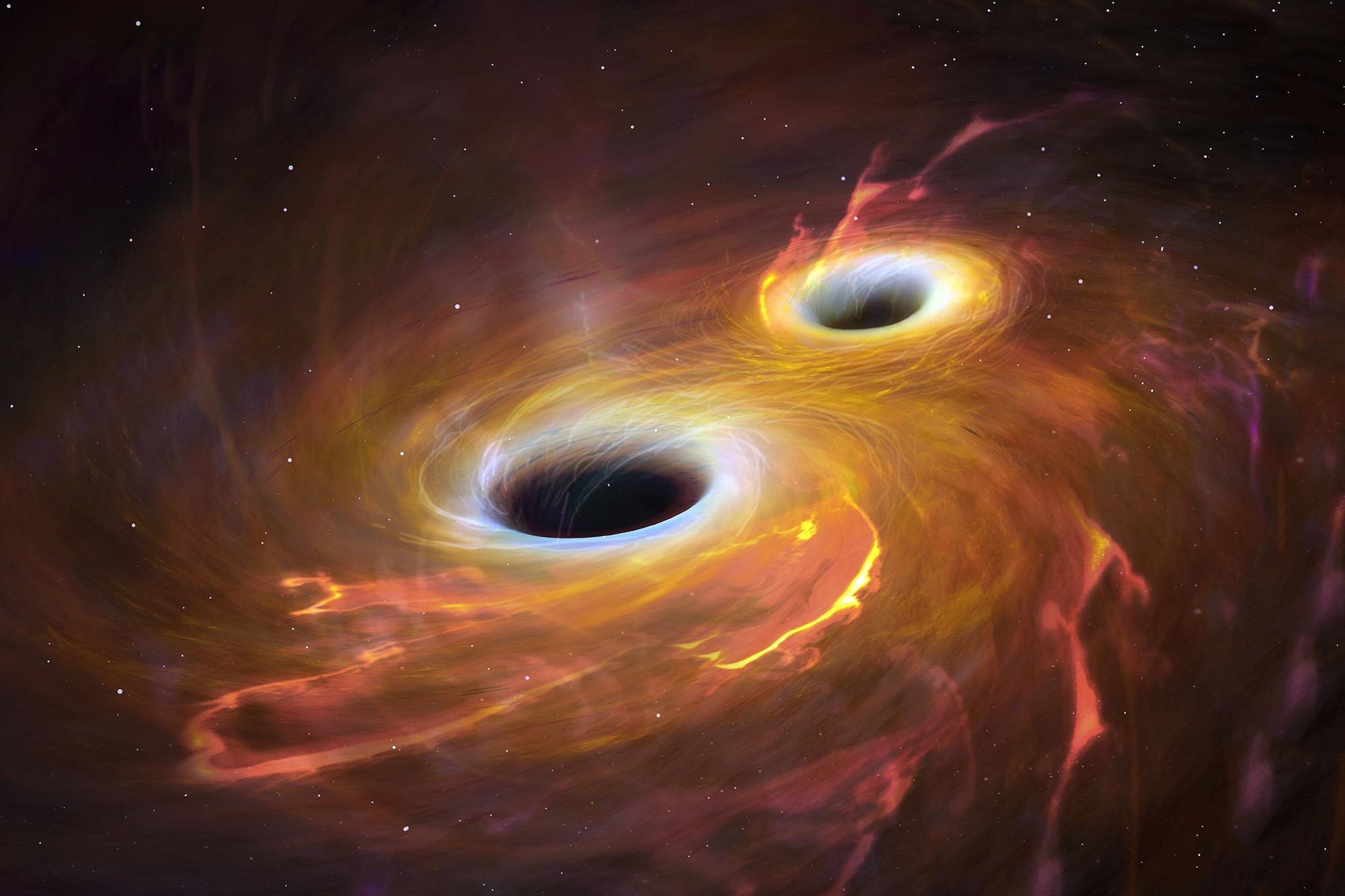Impresión de un artista de dos agujeros negros a punto de chocar.
Nuevas observaciones y análisis revelan dos agujeros negros Goliat separados por solo 750 años luz y acercándose, orbitando entre sí a raíz de una fusión de galaxias.
Astrónomos del Instituto Flatiron y sus colegas han descubierto dos Goliat fantasmales en su camino a una reunión catastrófica. Los astrónomos hicieron el anuncio el 9 de enero en la reunión de la Sociedad Astronómica Estadounidense en Seattle y en un artículo publicado en la revista Cartas de revistas astrofísicas.
Si bien los agujeros negros supermasivos cósmicamente muy juntos están a solo 750 años luz de distancia, no se fusionarán hasta dentro de unos cientos de millones de años. Mientras tanto, el descubrimiento de los astrónomos proporciona una mejor estimación de la cantidad de agujeros negros supermasivos que también están cerca de colisionar en el universo.

La concepción de este artista muestra una fusión galáctica en etapa tardía y dos agujeros negros centrales recién descubiertos. Los agujeros negros binarios son los más cercanos observados en múltiples longitudes de onda. Crédito: ALMA (ESO/NAOJ/NRAO); madre. Weiss (NRAO/AUI/NSF)
Este número mejorado de vértices ayudará a los científicos a sintonizar el coro de intensas ondas en el espacio-tiempo que se extiende por todo el universo conocido como[{» attribute=»»>gravitational waves, the largest of which are products of supermassive black holes close to collision in the aftermath of galaxy mergers. Detecting that gravitational-wave background will improve estimates of how many galaxies have collided and merged in the universe’s history.
The short distance between the newly discovered black holes “is fairly close to the limit of what we can detect, which is why this is so exciting,” says study co-author Chiara Mingarelli, an associate research scientist at the Flatiron Institute’s Center for Computational Astrophysics in New York City.
Due to the small separation between the black holes, the astronomers could only differentiate between the two objects by combining many observations from seven telescopes, including NASA’s Hubble Space Telescope. (Although supermassive black holes aren’t directly visible through an optical telescope, they are surrounded by bright bunches of luminous stars and warm gas drawn in by their gravitational pull.)

Telescope observations of two newly discovered supermassive black holes on a collision course. Their host galaxy, left, is a mash-up of two galaxies that have collided. The pink box shows the location of the supermassive black holes. Close observation of the pair, right, reveals two distinct black holes (white spots) only 750 light-years apart. Credit: M.J. Koss et al.
The astronomers found the pair quickly once they started looking, which means that close-together supermassive black holes “are probably more common than we think, given that we found these two and we didn’t have to look very far to find them,” Mingarelli says.
The newly identified supermassive black holes inhabit a mash-up of two galaxies that collided around 480 million light-years away from Earth. Gargantuan black holes live in the heart of most galaxies, growing bigger by gobbling up surrounding gas, dust, stars, and even other black holes. The two supermassive black holes identified in this study are true heavyweights: They clock in at 200 million and 125 million times the mass of our sun.
The black holes met as their host galaxies smashed into each other. Eventually they will begin circling each other, with the orbit tightening as gas and stars pass between the two black holes and steal orbital energy. Ultimately the black holes will start producing gravitational waves far stronger than any that have previously been detected, before crashing into each other to form one jumbo-size black hole.
La concepción de este artista muestra una fusión galáctica en etapa tardía y dos agujeros negros centrales recién descubiertos. Los agujeros negros binarios son los más cercanos observados en múltiples longitudes de onda. crédito:[{» attribute=»»>ALMA (ESO/NAOJ/NRAO), M. Koss et al (Eureka Scientific), S. Dagnello (NRAO/AUI/NSF)
Prior observations of the merging galaxies saw only a single supermassive black hole: Because the two objects are so close together, scientists couldn’t definitively tell them apart using a single telescope. The new survey, led by Michael J. Koss of Eureka Scientific in Oakland, California, combined 12 observations made on seven telescopes on Earth and in orbit. Although no single observation was enough to confirm their existence, the combined data conclusively revealed two distinct black holes.
“It’s important that with all these different images, you get the same story — that there are two black holes,” says Mingarelli, when comparing this new multi-observation research with previous efforts. “This is where other studies [of close-proximity supermassive black holes] Cayeron en el pasado. Cuando la gente los siguió, resultó que solo había un agujero negro. [This time we] Muchas notas, todas de acuerdo.

Representación esquemática de las etapas más importantes y los mecanismos físicos críticos que impulsan la fusión de dos agujeros negros supermasivos y las correspondientes escalas temporales y espaciales representativas. Crédito: José Utreras/Ezequiel Treister, Centro de Astrofísica y Tecnologías Asociadas (CATA); Michael Koss (Eureka Scientific), et al.
Ella y el científico visitante del Instituto Flatiron, Andrew Casey Clyde, utilizaron las nuevas observaciones para estimar la población del universo de agujeros negros supermasivos que se fusionan, y descubrieron que «puede ser sorprendentemente alta», dice Mingarelli. Predicen una abundancia de pares de agujeros negros supermasivos, que generan una gran cantidad de ondas gravitacionales ultrafuertes. Todo ese bullicio debería dar como resultado un fuerte fondo de ondas gravitacionales que es más fácil de detectar que si la población fuera más pequeña. La primera detección de vibraciones de fondo de ondas gravitacionales podría llegar «muy pronto», dice Mingarelli.
Referencia: «UGC 4211: Núcleos galácticos doblemente activos confirmados en el universo local a una separación nuclear de 230 PS» por Michael J. Benny Trachtenbrot, Franz E. Bauer, George C. Brevon, Claudio Ricci, Richard Moshotsky, Loreto Barcus-Muñoz, Laura Plesha, Thomas Connor, Fiona Harrison, Tingting Liu, Macon Magno, Chiara MF Mingarelli, Francesco Mueller-Sanchez, Kyosuke Oh , Taro Shimizu, Krista Lynn Smith, Daniel Stern, Miguel Parra Tello y C. Megan Urey 9 de enero de 2023, disponible aquí. Cartas de revistas astrofísicas.
DOI: 10.3847/2041-8213/aca8f0

«Organizador aficionado. Aspirante a evangelista de la cerveza. Fanático de la web en general. Ninja certificado de Internet. Lector ávido».







More Stories
La NASA está cerca de decidir qué hacer con la problemática nave espacial Starliner de Boeing
Los físicos ofrecen un método para la detección mecánica de desintegraciones nucleares individuales
La aurora boreal podrá ser visible desde Nueva York hasta Idaho